Vital Veggies
Today I’m talking to you about vegetables and fruit. The BNF would like you to achieve your ‘5-a-day’ target, but is that really enough?
We’re bombarded by the ‘5-a-day’ message, but some studies suggest that ‘7-10 a day’ would be far better in terms of improving our long-term health. For example, the recent EPIC study, which was indeed truly epic, showed that the greatest benefit came from eating more than 569g fruit and vegetables, especially vegetables, each day. That’s at least 7 portions.
The ‘5-a-day’ message was introduced because it was thought that most people wouldn’t achieve a higher target. Indeed, in 2015 it was reported that up to 75% of adults may not be achieving 5-a-day, with 16-24 year olds being least likely to get sufficient.
Both fruits and vegetables in a variety of colours provide a range of vitamins, minerals and plant nutrients essential to good health. As some fruits can be high in sugar, I tend to recommend eating more vegetables than fruit; limit your fruit to 1-2 pieces a day.

Berries are packed with nutrients, and provide a touch of sweetness without a big effect on your blood sugar.
Some people say you should avoid eating fruit if you want to lose weight. I haven’t found any evidence to support that. Indeed eating fruit is associated with a reduced risk of many chronic conditions, including high blood pressure and type 2 diabetes. If you’re trying to lose weight, stick to berries and orchard fruits (if you like numbers, anything with a GL of 7 or less), and avoid sweeter tropical fruits.
So, how can you get more veggies and fruits into your diet? Here are 7 quick tips:
-
Take portable veggies to work. Cherry tomatoes, sugar snap peas and baby carrots are all durable, and require no preparation. Eat them with houmous or guacamole if you don’t want them by themselves.
-
Put together all your leftover veggies and make a big batch of vegetable soup. Freeze in portion sizes for a fuss-free meal when you need it. A great way of avoiding food waste.
-
Small portions of leftover veg? Mix them with beaten egg and a little cheese, decant into cupcake cases and bake for 15 minutes for simple breakfast muffins that can also be eaten on the go.]
-
Search the Internet for unusual recipes involving vegetables in unlikely places. For example sweet potato or beetroot brownies, or avocado chocolate mousse. These aren’t super-healthy, of course, but may be a way of boosting veg intake in veggie-phobes, and are great for occasional novelty value.
-
Eat a small bowl of salad at the start of your main meal. Bitter leaves such as rocket or watercress may help with your digestion, and you can add variety by adding in a couple of different vegetables every day. For example, one day you could be simple and classic with tomato and cucumber, and another day you could go Mediterranean and use grilled peppers and courgettes. The possibilities are endless.
-
Chop and freeze ripe fruit that you’re not going to eat. Blend it with yoghurt or equivalent and half a frozen banana for an instant iced dessert. If you have a machine that really churns frozen fruit to an ice cream consistency, so much the better. If your fruit is sweet enough you won’t need the banana, and if your machine churns properly you can forego the yoghurt too if you like.
-
Use cauliflower or broccoli in place of rice (simply blitz it in the food processor, or grater), and courgettes or carrots instead of noodles. It’s best to make these at home with a small device like a pencil sharpener, but if you really can’t stand the idea, most supermarkets sell pre-spiralized veggies.




